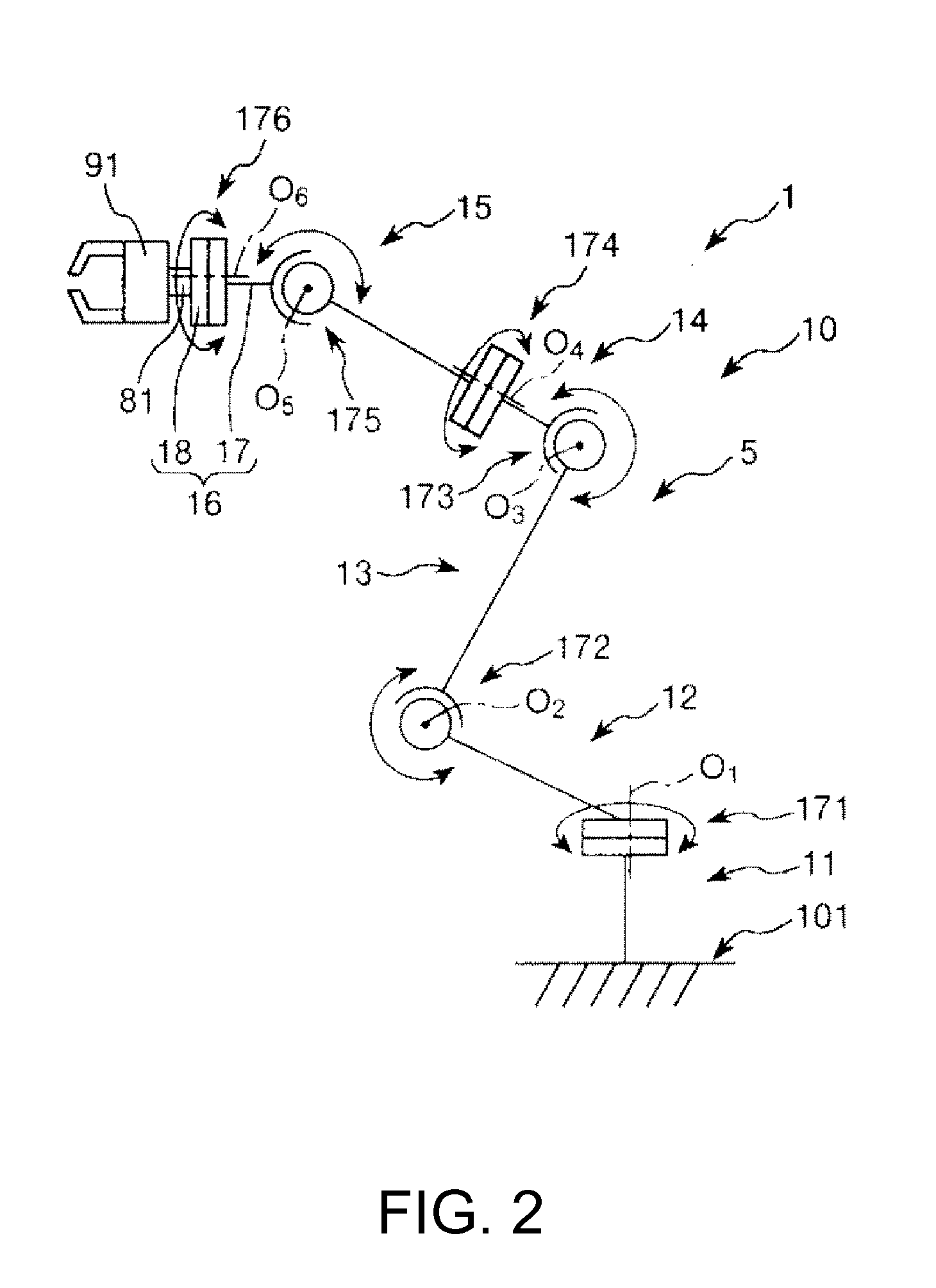Robot, robot system, and robot control device
a robot and control device technology, applied in the field of robots, can solve the problems of inability to accurately perform the control of keeping the polishing force (the force applied to the target) fixed, the accuracy of force detection deteriorates, and the cycle time of the work performed using the force sensor increases, so as to achieve the effect of accurately keeping the force applied to the machining target fixed and accurate keeping the force applied to the machining targ
- Summary
- Abstract
- Description
- Claims
- Application Information
AI Technical Summary
Benefits of technology
Problems solved by technology
Method used
Image
Examples
first embodiment
[0057]FIG. 1 is a perspective view of a robot according to a first embodiment of the invention viewed from the front side. FIG. 2 is a schematic diagram of the robot shown in FIG. 1. FIG. 3 is a block diagram of a main part of the robot shown in FIG. 1. FIG. 4 is a circuit diagram showing the configuration of a part of a force sensor of the robot shown in FIG. 1. FIG. 5 is a timing chart showing the operation of the robot shown in FIG. 1 in a period including a period of initialization of a force sensor. FIG. 6 is a flowchart for explaining a control operation of a robot control device of the robot shown in FIG. 1. FIGS. 7 to 10 are diagrams for explaining an operation in work of the robot shown in FIG. 1.
[0058]Note that, in the following explanation, for convenience of explanation, the upper side in FIGS. 1, 2, and 7 to 10 is referred to as “up” or “upward” and the lower side in the figures is referred to as “down” or “downward”. The base side in FIGS. 1, 2, and 7 to 10 is ref...
second embodiment
A Robot
[0103]FIG. 11 is a schematic diagram showing a robot according to a second embodiment of the invention.
[0104]Differences of the second embodiment from the first embodiment are mainly explained below. Explanation of similarities is omitted.
[0105]As shown in FIG. 11, a robot 1A in the second embodiment is a double-arm robot. The robot main body 10 of the robot 1A includes two robot arms 5 and a body section 110 functioning as a base (a supporting section) that supports the robot arms 5. For example, the robot 1A can perform work by gripping the insertion object 41 with one of two hands 91 and gripping the insertion target 46 with the other.
[0106]With the robot 1A, effects same as the effects in the first embodiment can be obtained.
[0107]Since the robot 1A is a double-arm robot, the robot 1A can perform various operations and can perform various kinds of work.
[0108]Note that the number of robot arms is not limited to two and may be three or more.
third embodiment
[0109]FIG. 12 is a perspective view showing a robot system according to a third embodiment of the invention.
[0110]Differences of the third embodiment from the first embodiment are mainly explained below. Explanation of similarities is omitted.
[0111]As shown in FIG. 12, a robot system 100 includes a robot 1B and a robot control device (a control unit) 20, which is separate from the robot 1B. In the robot 1B, the robot control device 20 is excluded from the robot 1 in the first embodiment. The robot 1B and the robot control device 20 are electrically connected by a cable 25.
[0112]Note that the robot 1B and the robot control device 20 may be configured to perform communication by radio.
[0113]With the robot system 100, effects same as the effects in the first embodiment can be obtained. Note that this embodiment can be applied to the second embodiment as well.
[0114]The robot, the robot system, and the robot control device according to the embodiments of the invention are e...
PUM
 Login to View More
Login to View More Abstract
Description
Claims
Application Information
 Login to View More
Login to View More - R&D
- Intellectual Property
- Life Sciences
- Materials
- Tech Scout
- Unparalleled Data Quality
- Higher Quality Content
- 60% Fewer Hallucinations
Browse by: Latest US Patents, China's latest patents, Technical Efficacy Thesaurus, Application Domain, Technology Topic, Popular Technical Reports.
© 2025 PatSnap. All rights reserved.Legal|Privacy policy|Modern Slavery Act Transparency Statement|Sitemap|About US| Contact US: help@patsnap.com



